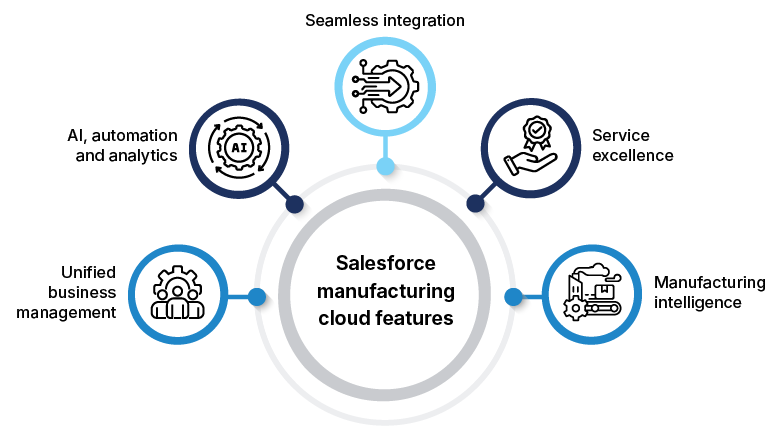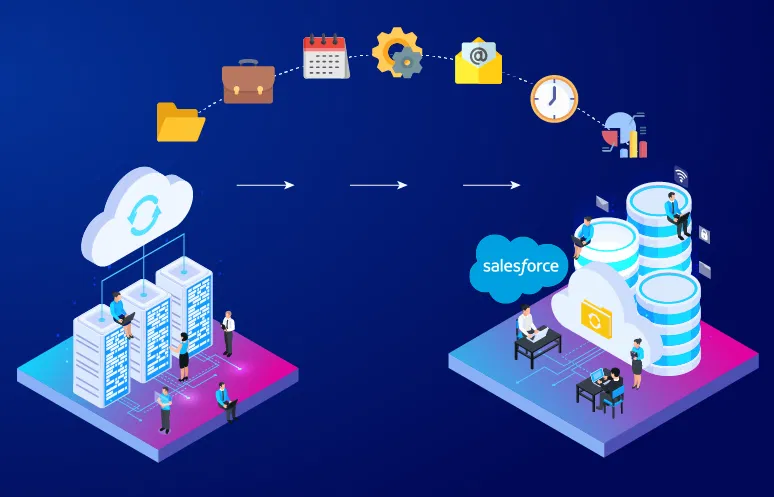In many organizations, sales commit to a record-quarter target even as operations rely on outdated forecasts, and finance is left reconciling the gap just hours before the board meeting. If you’ve faced conflicting forecasts and similar last-minute board reconciliations, you’ll see why a single Manufacturing Cloud platform is essential.
Salesforce manufacturing cloud replaces platform replaces disconnected spreadsheets and point solutions with a single, real-time workspace where sales, service, and production share the same facts. This article breaks down what it does, who benefits, and the AI-powered features that help manufacturers respond faster, plan smarter, and serve customers better. Whether you manage the shop floor or steer P&L performance, you’ll leave with a clear roadmap to stronger collaboration and healthier margins.
What is Salesforce Manufacturing Cloud?
Salesforce Manufacturing Cloud is a purpose-built, cloud-based CRM solution designed for the unique needs of manufacturers. Built on the Salesforce platform, it extends core sales and service capabilities with specialized tools such as Sales Agreements and Account-Based Forecasting.
This central workspace unifies sales pipeline data with long-term contract commitments and real-time production metrics to give teams immediate visibility into demand signals and capacity constraints. By embedding analytics and automation directly into the process, the platform helps teams move beyond static spreadsheets and siloed applications.
Manufacturing Cloud’s native integration with ERP systems, MuleSoft APIs, and the AppExchange ecosystem means companies can connect order management, inventory, and service workflows without custom code. With built-in AI features in CRM Analytics, teams can spot trends, predict shortfalls, and respond faster. Its purpose is to transform disconnected data into a unified process tailored for manufacturing operations.
Who is Salesforce Manufacturing Cloud for?
By uniting sales, finance, operations, and service in one platform, Salesforce Manufacturing Cloud gives every team and stakeholder real-time visibility and a shared set of data. Here are the key roles that benefit most:
CEOs and COOs
Seek end-to-end visibility into order-to-cash processes and stronger alignment between sales forecasts and plant capacity.
CFOs and finance leaders
Need accurate, account-based forecasting and real-time financial insights to manage working capital and drive predictable margin performance.
Sales and commercial heads
Require a single source of truth for sales agreements, volume commitments, and pricing flexibility to hit revenue targets.
Operations and supply chain managers
Depend on up-to-date demand signals and production schedules to optimize throughput, reduce stockouts, and avoid overproduction.
IT and solution architects
Value a configurable, API-first platform that integrates CRM, ERP, and analytics without extensive custom development.
Customer success and service leads
Leverage service history and contract terms to deliver proactive maintenance and stronger post-sale relationships.
How Salesforce Manufacturing Cloud works
Manufacturing Cloud streamlines the order-to-revenue lifecycle in four connected stages. Each stage shares data seamlessly, so forecasts, agreements, and orders stay aligned across every team. The stages are:
Opportunity management
Sales teams create and track new opportunities – projects, deals, or renewals using familiar CRM tools. Each opportunity captures customer requirements, products, quantities, and timelines.
Sales agreements
Once terms are set, opportunities convert into long-term sales agreements. These agreements record start and end dates, scheduled volumes, pricing tiers, and performance metrics on a single interface.
Forecast grid
Agreement data flows into the forecast grid, where teams can adjust commitments based on actual sales, market shifts, or seasonal trends. Built-in collaboration features let sales, operations, and finance update forecasts together in real time.
Order execution
Approved forecasts trigger order releases and inventory reservations in the connected ERP. Production schedules, capacity planning, and service commitments all align to the same source of truth, reducing delays and errors.
This end-to-end flow replaces fragmented spreadsheets and point solutions with a unified, transparent process.
5 Key Salesforce manufacturing cloud features
Salesforce Manufacturing Cloud includes a set of purpose-built capabilities that streamline key manufacturing processes without the need for extensive customization. Below are the five core built-in features that drive real-time collaboration, predictive planning, and service excellence.
Unified business management
Capture opportunities, sales agreements, long-term projects, and demand forecasts in one workspace. Sales agreements record start and end dates, scheduled volumes, pricing tiers, and performance metrics. Agreement data then feeds directly into forecasting and order execution, so every team works from the same set of facts.
AI, automation and analytics
Gain actionable insights at scale with prebuilt CRM Analytics dashboards and Einstein Prediction Builder. Automate workflows with point-and-click Flow tools to handle price-tier escalations, volume-change approvals, and customer notifications. Combined, these features summarize revenue trends, flag supply risks, and recommend next steps without custom code.
Seamless integration
Connect your CRM to ERP, MES, and other back-office systems via MuleSoft APIs or more than 3,000 AppExchange connectors. Opportunities, forecasts, and service records sync automatically, removing manual handoffs and ensuring order, inventory, and production schedules stay aligned.
Service excellence
Deliver proactive maintenance and differentiated partner experiences with manufacturing cloud for service. Use case management, partner and customer portals, and service-oriented dashboards to track warranty events, field-service calls, and post-sale renewals, all tied back to contract terms and forecast data.
Manufacturing intelligence
Make informed decisions with embedded insights that span the entire value chain. Real-time visibility into capacity utilization, backlog status, and supplier performance lets teams anticipate bottlenecks and optimize throughput. Predictive recommendations help you reduce stockouts, avoid overproduction, and improve working capital.
Business benefits of Salesforce Manufacturing Cloud
Manufacturing Cloud delivers rapid, measurable returns across forecasting, operations, finance, and service. Organizations often see results within weeks of deployment. Here are six benefits you can quantify right away:
Higher operational efficiency
Automate repetitive workflows and eliminate manual handoffs, with sales agreements, price-tier approvals, and service triggers running on Flow without code, so your teams focus on strategic work instead of routine tasks.
More accurate forecasts
Replace static spreadsheets with account-based forecasting and a collaborative forecast grid to boost forecast accuracy by 45 percent Salesforce.
Faster order-to-cash and sales productivity
Integrate CPQ, contract lifecycle management, and order automation. Deals move seamlessly from quote to invoice, reducing bottlenecks and helping sales reps close business more efficiently.
Reduced inventory and cost optimization
Gain real-time visibility into demand signals and stock levels to prevent overstock or stockouts, optimize resource allocation, and lower overall carrying costs.
Enhanced service revenue and responsiveness
Use Manufacturing Cloud for Service to automate warranty claims, field-service scheduling, and service-revenue forecasting, resulting in up to a 40 percent reduction in case resolution times and stronger contract renewals.
Single-source visibility for smarter decisions
Embedded analytics, CRM dashboards, and a unified data model turn scattered ERP, CRM, and shop-floor inputs into actionable insights. They help you spot bottlenecks, optimize throughput, and protect margins.
Real-world use cases of Salesforce Manufacturing Cloud
Salesforce Manufacturing Cloud brings strategy to the shop floor, turning data and AI into real-world improvements in uptime, service speed, and cross-team collaboration. The use cases below show how manufacturers move from reactive crisis management to proactive operations.
Real-time field service enablement
Manufacturing Cloud’s Agentforce integration delivers a unified mobile platform that gives technicians instant access to repair histories, parts availability, and work instructions. Managers gain visibility into job status and SLAs, enabling proactive dispatch decisions and reducing idle time on every service call.
Luminator Technology Group embeds Agentforce within Manufacturing Cloud to give field technicians and support teams on-demand access to repair histories and work instructions. This real-time insight streamlines maintenance workflows and cuts service disruptions.
Proactive appliance maintenance
By combining IoT telemetry with Manufacturing Cloud for Service, customer data flows seamlessly into warranty and service workflows. It also triggers automated alerts when appliances report anomalies. This allows service teams to schedule technician visits only when needed, anticipate failures, and minimize emergency call-outs.
Fisher & Paykel integrates IoT telemetry into Manufacturing Cloud for Service, automating warranty claims and scheduling technician visits only when truly needed. This proactive approach reduces unnecessary service calls and enhances customer satisfaction.
AI-driven sales productivity
Einstein 1 Sales empowers reps with AI-generated quotes, dynamic pricing recommendations, and next-best-action prompts. These features pre-populate custom stone order details based on historical patterns and current inventory. This intelligence-driven approach frees reps to focus on relationship building and closing deals.
BACA Systems leverages Einstein 1 Sales in Manufacturing Cloud to auto-generate accurate quotes, suggest optimal upsell opportunities, and remove manual data entry. Sales reps spend less time on administration and more time closing deals.
Unified demand forecasting across divisions
Manufacturing Cloud centralizes sales, production, and service data into one forecast grid. AI algorithms then blend historical orders, seasonal trends, and open opportunities to generate rolling forecasts. Cross-functional teams collaborate directly in the grid to adjust volumes and plan capacity in real time.
Kawasaki Motors Corp., U.S.A. (Engines Division) consolidates sales, production, and service data in Manufacturing Cloud. Real-time dashboards and AI-powered forecasting let teams anticipate parts demand and align support programs across its global network.
Integrated quoting and partner collaboration
Manufacturing Cloud’s integration with Experience Cloud spins up reseller portals in days. Partners can then view pricing, generate certified quotes, and submit orders against live contract terms. Back-office teams gain visibility into channel pipelines to reduce emails and ensure order compliance.
Swissbit rolled out Manufacturing Cloud to centralize custom quoting and built an Experience Cloud portal for resellers. Partners register products, track opportunities, and manage orders within a unified platform, eliminating spreadsheet chaos.
Salesforce Manufacturing Cloud vs traditional manufacturing CRMs
When choosing a CRM for manufacturing, it’s essential to compare purpose-built platforms against generic solutions. The table below contrasts core capabilities of Salesforce Manufacturing Cloud with traditional manufacturing CRMs, highlighting where Manufacturing Cloud delivers clear business advantage.
| Capability | Salesforce Manufacturing Cloud | Traditional Manufacturing CRMs |
| Unified value chain |
|
|
| Forecasting and customer-centric operations |
|
|
| AI, automation and analytics |
|
|
| Seamless integration and ecosystem |
|
|
| Scalability and flexibility |
|
|
| Service management and excellence |
|
|
| Total cost of ownership |
|
|
This streamlined comparison highlights how Salesforce Manufacturing Cloud not only unifies processes and data but also scales easily, automates intelligently, and lowers total cost of ownership compared with traditional CRM approaches.
How AI and Data Cloud elevate Manufacturing Cloud
Salesforce for manufacturing leverages Data Cloud and embedded AI to unify transactional, operational, and IoT data into a single intelligence layer. This integration enables proactive decision making and delivers real-time analytics at scale. Below are three standout examples of AI in manufacturing cloud in action:
Agentforce AI agents
Leverage natural-language processing and live Data Cloud signals to automate tasks such as assigning work orders based on technician skills, historical performance, and location, ensuring the right expert arrives first time.
Advanced account-based forecasting
Merges Sales Agreements with live opportunity data, external factors like seasonality, and continuous analytics to power a dynamic forecast grid where teams adjust commitments collaboratively in real time.
Predictive customer insights
Analyzes service history, IoT telemetry, and usage patterns in Data Cloud to flag at-risk accounts, recommend upsell opportunities, and personalize service outreach.
This AI-powered, scalable architecture ensures that as your data grows, your forecasts, resource plans, and customer experiences all improve without added complexity.
Popular integrations with Salesforce Manufacturing Cloud
Salesforce Manufacturing Cloud offers seamless connectors to extend its capabilities across your enterprise ecosystem. Popular integrations include:
- ERP systems: Sync orders, inventory, billing, and financial data in real time with SAP, Oracle, or Microsoft Dynamics
- MES platforms: Ingest production schedules, machine metrics, and quality data for end-to-end operational visibility
- CPQ (Revenue Cloud): Automate product configuration, pricing, quoting, contract management, and billing directly from your CRM
- Service Cloud: Unify warranty tracking, claims management, and field-service dispatch in a single console
- Commerce and order management: Centralize customer and partner ordering, fulfillment status, and cost-optimization workflows on one platform
- MuleSoft Anypoint Platform: Use prebuilt connectors and APIs to integrate any application, data source, or IoT platform without code
- Tableau for manufacturing intelligence: Embed advanced visual analytics to surface trends, forecast demand, and monitor KPIs across the value chain
Eliminate forecast friction and drive operational alignment
Recurring last-minute reconciliations and disconnected processes can turn every board review into a critical challenge, slowing decisions and eroding margins. If you’ve found yourself scrambling to align sales commitments with production capacity and financial forecasts, it’s time for a unified approach. Start by pinpointing which processes—whether account-based forecasting, partner order management, or field-service coordination—would benefit most from real-time collaboration.
Softweb Solutions’ industry-focused Salesforce consulting services help manufacturers bridge these gaps, guiding you from solution design through deployment and user adoption. Let’s explore how you can streamline processes, automate key workflows, and empower every stakeholder with a single platform so your next quarter begins with confidence instead of uncertainty. Talk to our certified Salesforce consultant to get started.
FAQs
What is Salesforce Manufacturing Cloud?
Salesforce Manufacturing Cloud is exactly what the name says. It is a cloud-based CRM platform built for manufacturing companies to manage their sales, operations, and customer relationships more efficiently. It brings together CRM data and production planning in one platform.
What are the key features of Salesforce Manufacturing Cloud?
Key features of Salesforce Manufacturing Cloud include sales agreements, account-based prediction, real-time performance monitoring, integration with ERP systems, and customer collaboration tools. These help manufacturers with accurate demand estimates and better visibility across operations.
How does Manufacturing Cloud enhance customer relationships?
Manufacturing Cloud provides a unified platform that fosters collaboration, transparency, and proactive engagement. It gives the complete view of customer accounts, containing previous orders, present agreements, and future requirements. This helps sales and service teams offer pre-emptive support, build faith, and support prolonged associations.
Can Salesforce Manufacturing Cloud be customized for different manufacturing sectors?
Yes, Salesforce Manufacturing Cloud is flexible and can be personalized to fit the needs of different sectors such as automotive, electronics, industrial equipment, and consumer goods manufacturing. A certified Salesforce partner like Softweb Solutions can help you customize Salesforce Manufacturing Cloud to cater to your unique requirements. Talk to our experts to discuss your requirements.
How do I get started with Salesforce Manufacturing Cloud?
To get started, you must explore its capabilities for sales and service. Then you can connect with a certified Salesforce consultant who understands manufacturing requirements. They will help you integrate Salesforce with your existing systems efficiently. Our certified Salesforce developers have years of experience in developing tailored solutions to meet specific business needs.
Connect with our certified Salesforce consultant to discuss your business needs and explore how we can start integrating Salesforce Manufacturing Cloud with your business.





